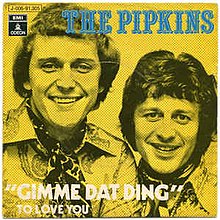Gimme Dat Ding
| "Gimme Dat Ding" | |
|---|---|
 | |
| Single by The Pipkins | |
| from the album Gimme Dat Ding | |
| B-side | "To Love You" |
| Released | May 1970 |
| Genre | |
| Length | 2:10 |
| Label | EMI |
| Songwriter(s) | Albert Hammond and Mike Hazlewood |
| Producer(s) | John Burgess |
| Official Audio | |
| "Gimme Dat Ding" on YouTube | |
"Gimme Dat Ding" is a 1970 popular UK song, of the novelty type, sung by "one-hit wonder" The Pipkins, and written and composed by Albert Hammond and Mike Hazlewood. Released as a single, it is the title selection of an album which The Pipkins recorded and released on the EMI Columbia Records label. It also appeared on a compilation album of the same name, which The Pipkins shared with another up-and-coming UK group, The Sweet. It has also been included on many other compilation albums. "Gimme Dat Ding" was arranged by Big Jim Sullivan.
Chart history
[edit]The song peaked at number 6 on the UK Chart in March/April 1970. It reached number 7 in Canada, number 9 on the US Hot 100 and number 20 in US Easy Listening.[2] It did best in New Zealand, where it reached number 1.[3]
Weekly charts[edit]
|
Year-end charts[edit]
|
Song profile
[edit]"Gimme Dat Ding" is a call-and-response duet between a deep, gravelly voice, that of Tony Burrows, and a high tenor, that of Roger Greenaway. The voices are said to represent a piano and a metronome. The piano is honky-tonk style.
When Hammond and Hazlewood wrote and composed "Gimme Dat Ding," it was one selection from their musical sequence "Oliver in the Overworld," which formed part of the British children's show Little Big Time, hosted by Freddie and the Dreamers; this narrated a surreal story of a little boy seeking the parts to mend his grandfather clock. The lyrics relate to this story, the song being sung by a metronome who has been expelled by the Clockwork King. The "ding" has been stolen from the metronome by the "Undercog". The original version, as performed by Freddie Garrity, was released on the album Oliver in the Overworld in 1970.
Cover versions
[edit]Comedian Frankie Davidson and pop group Maple Lace each released a cover version in Australia in 1970, reaching 21 on the local charts, which was credited to both artists.[18][19] A Czech version "Gimi Det Ding" was also released in 1970 as a vinyl single with alternative Czech lyrics (a silence-loving man complaining about his noisy female neighbour singing).[20] The Norwegian vocal group Bjelleklang covered the song on their album YppeRu’ dOnK in 1994. The song was called Gummihatt (Swing) which is Rubberhat (Swing) in English.[21]
In the UK, interest in the song resurfaced in the 1990s when the Maynards confectionery company used it in a popular television commercial for their Just Fruits fruit pastille and fruit gum range between 1992 and 1994; the song began reappearing on radio playlists during that era. In 1997, Dairylea also used the song in a series of advertisements in the UK.[citation needed]
An instrumental version arranged by Ronnie Aldrich was frequently used as background music during comedy sketches in The Benny Hill Show.[citation needed]
The song is also played in the year finale of the Russian game show 'What? Where? When?' while a TV viewer who wrote the question currently played sits alongside the 'experts'.
The Shaggs, a foundational outsider music rock band formed by three sisters living in Fremont, New Hampshire, released a cover of the song on the album Shaggs' Own Thing. It was recorded live at a dance party in the Fremont, NH, town hall. [22]
References
[edit]- ^ Stanley, Bob (13 September 2013). "1970: Everything's Gone Gray". Yeah Yeah Yeah: The Story of Modern Pop. Faber & Faber. p. 285. ISBN 978-0-571-28198-5.
- ^ Whitburn, Joel (1993). Top Adult Contemporary: 1961–1993. Record Research. p. 188.
- ^ Flavour of New Zealand, 13 July 1970
- ^ Kent, David (1993). Australian Chart Book 1970–1992 (illustrated ed.). St Ives, N.S.W.: Australian Chart Book. p. 233. ISBN 0-646-11917-6.
- ^ "RPM Top 100 Singles - July 18, 1970" (PDF).
- ^ "The Irish Charts – Search Results – Gimme Dat Ding". Irish Singles Chart. Retrieved June 26, 2018.
- ^ "Jaaroverzichten – Single 1970" (in Dutch). Single Top 100. Hung Medien. Retrieved November 6, 2018.
- ^ Flavour of New Zealand, 13 July 1970
- ^ "SA Charts 1965–March 1989". Retrieved 5 September 2018.
- ^ "Official Charts Company". Retrieved 2018-11-05.
- ^ Joel Whitburn's Top Pop Singles 1955–1990 - ISBN 0-89820-089-X
- ^ Whitburn, Joel (1993). Top Adult Contemporary: 1961–1993. Record Research. p. 188.
- ^ Cash Box Top 100 Singles, July 18, 1970
- ^ "Item Display - RPM - Library and Archives Canada". collectionscanada.gc.ca. 17 July 2013.
- ^ "Google Translate".
- ^ "Top 100 Hits of 1970/Top 100 Songs of 1970". musicoutfitters.com. Retrieved 1 December 2017.
- ^ http://tropicalglen.com/Archives/70s_files/1970YESP.html Archived 2019-07-22 at the Wayback Machine Cash Box Year-End Charts: Top 100 Pop Singles, December 26, 1970
- ^ Kent, David (1993). Australian Chart Book 1970–1992 (illustrated ed.). St Ives, N.S.W.: Australian Chart Book. p. 83. ISBN 0-646-11917-6.
- ^ McFarlane, Ian (1999). "Encyclopedia entry for 'Maple Lace'". Encyclopedia of Australian Rock and Pop. St Leonards, NSW: Allen & Unwin. ISBN 1-86508-072-1. Archived from the original on 3 August 2004.
{{cite book}}: CS1 maint: unfit URL (link) - ^ "Miluše Voborníková & Jiří Grossmann - Gimi Det Ding [1970 Vinyl Records 45rpm]". YouTube. May 2014. Archived from the original on 2021-12-05.
- ^ Archived at Ghostarchive and the Wayback Machine: "Bjelleklang - Gummihatt (Swing)". YouTube. 24 November 2009.
- ^ "The Shaggs – 'Gimme Dat Ding'". YouTube. 9 November 2012.
